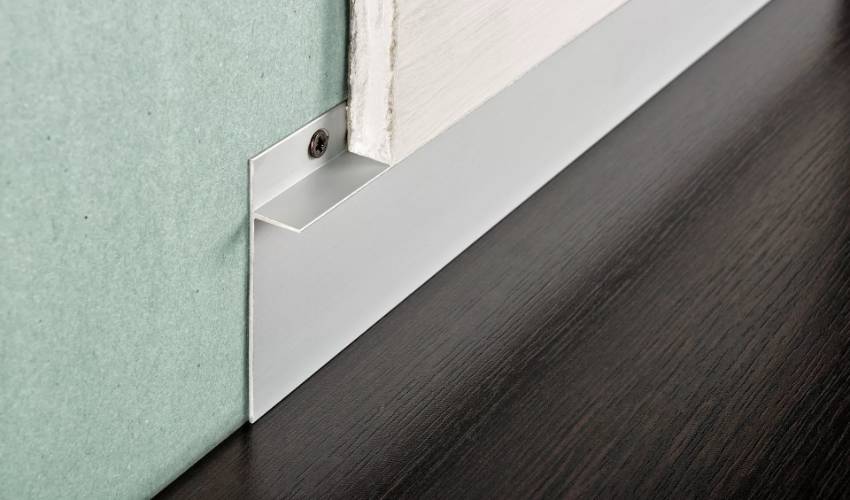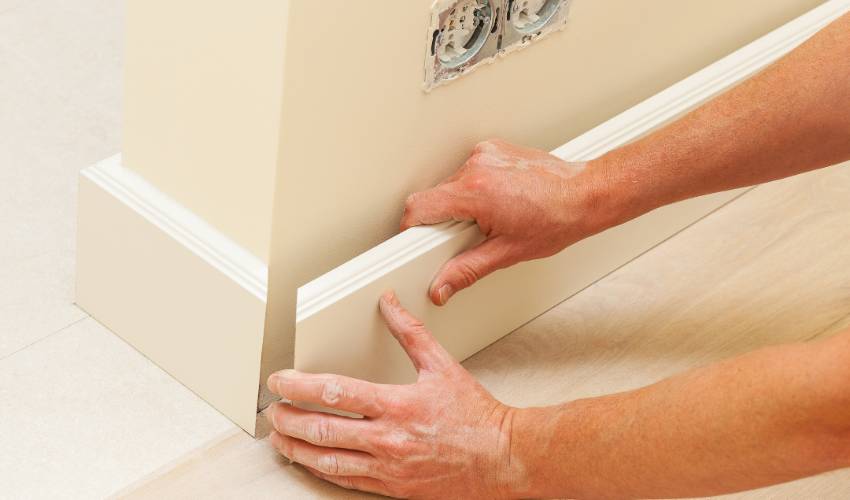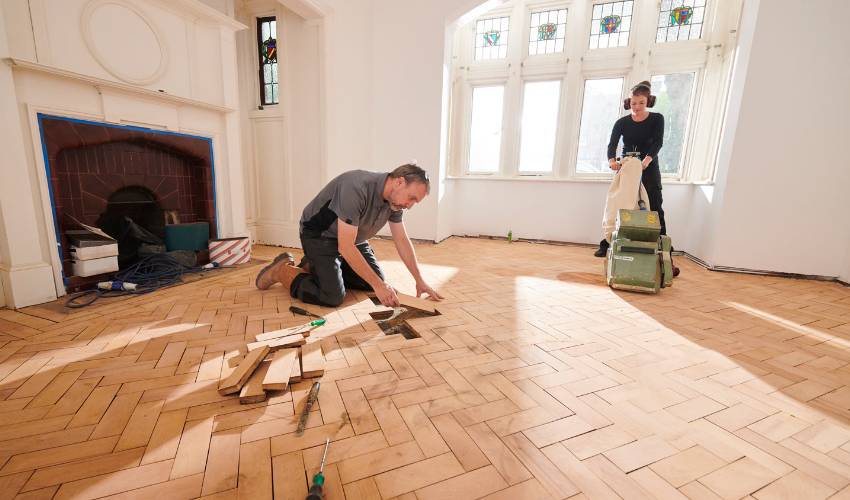Every little point matters when we talk about interior design. Floor skirting is one sometimes disregarded component that can significantly alter a room’s overall look.
Floor skirting, commonly referred to as baseboards or base molding, is a beautiful and useful finishing touch for every interior. It not only fills up the space’s gap between the floor and the wall but also gives it personality and charm.
Here, we’ll go over many floor skirting design options, things to keep in mind when purchasing them, how to install them, and crucial tips to ensure a perfect finish!
10 Different Types of Floor Skirting
There are several varieties of floor skirting, each with a unique design and material properties. Here are a few typical designs for floor skirting:
1. Wooden Skirting
Wooden skirting is a classy and adaptable option for bringing warmth and beauty into your interior spaces. Because it is available in various wood species, such as oak, pine, or walnut, you can select the type of wood that best matches your design. Wooden and PVC skirting can be stained, painted, or left unpainted for a more natural appearance to compliment your room’s design. Wooden skirting adds a finishing touch and even saves your walls from dings and damage.
2. Contrasting Color Skirting
Painting or staining the skirting boards in a color that contrasts with your walls is a design decision known as “contrast color skirting.” This strategy can make a strong visual statement, highlighting the wall’s foundation and bringing a splash of color into your room. It’s a wonderful way to make a strong design statement and give individuality to a space.
3. Metal Skirting
A sleek and contemporary choice is metal skirting, which is frequently composed of materials like aluminum or stainless steel. It is renowned for being long-lasting and simple to maintain, making it a good choice for high-traffic areas in particular. Metal skirting gives your interior design a contemporary feel and can be utilized in a variety of contexts, from industrially inspired areas to minimalist and modern spaces.
4. Flush Skirting
A simple design known as flush skirting places the skirting at the same level as the wall surface. This skirting makes the space neat and clean by starting a continuous transition from the wall to the floor. It is a common option in minimalist and modern home designs, where simplicity and consistency are emphasized.
5. Double Layer Skirting
As its name implies, double-layered skirting is higher than regular skirting boards. It consists of two layers, frequently with distinct profiles, giving your walls depth and dimension. This skirting is a fantastic option if you want to invest in your room with a sense of richness and elegance. It can work especially well in spaces with high ceilings.
6. Continuous Skirting
Continuous skirting is a design idea in which the skirting continues uninterruptedly down the whole length of a wall. This method gives a room a sense of flow and continuity, giving the impression that it is larger. Continued skirting is frequently utilized in open-plan living spaces to effortlessly integrate various regions.
7. MDF Skirting
Solid wood skirting is expensive; a more economical option is MDF (Medium-Density Fiberboard) skirting. It comes in a variety of styles and finishes and is created from engineered wood fibers. Skirting made of MDF is simple to paint and can be matched to your décor. Although it might not have the same natural beauty as wood, it offers a cheap way to give your house a polished appearance.
8. Tile Skirting
Tile skirting is a sensible option for moist areas like bathrooms and kitchens. The floor tiles must be extended up the wall to show a soft change. In addition to shielding the walls from water damage, tile skirting gives tiled surfaces a polished appearance. To fit your tastes for design, it comes in a wide variety of tile designs and colors.
9. Plaster Skirting
Plaster skirting is a classic and aesthetically pleasing option that gives your rooms a hint of architectural flair. Plaster skirting can be used to make complicated patterns and motifs that will improve the aesthetic appeal of your area. Plaster skirting, though it necessitates skilled installation, can be a lovely feature to traditional or historic homes.
10. Marble Skirting
Marble skirting is the height of elegance and luxury. It entails making your floor skirting out of marble, which gives it a classy look and goes well with marble flooring if you have any. Marble skirting is a great option for posh bathrooms and opulent living spaces since it is incredibly durable and moisture-resistant.
Pick the floor skirting type that best meets your interior design aesthetic and practical requirements from those listed above because each has distinctive qualities and an appealing appearance of its own. There is a skirting choice to improve the aesthetic of your room, whether you choose the coziness of wood, the modernism of metal, or the classic elegance of marble.
What Are the Factors That You Must Consider When Buying Floor Skirting?
When you decide to make a purchase, you must first think about the aspects that will help you make the best decision! Therefore, the following are some important aspects to think about while purchasing floor skirting for your place:
1. The Type of Room
Consider the function of the room where you plan to install floor skirting. Different rooms may have different requirements. For example, a formal living room can benefit from more ornate skirting, while a kitchen might require a more durable and easy-to-clean option.
2. The Height of the Ceilings
Ceiling height can influence the choice of floor skirting. In rooms with high ceilings, taller skirting can create an elegant and balanced look, whereas lower ceilings may require shorter skirting to avoid overwhelming the space.
3. Material
Floor skirting comes in various materials, including wood, metal, MDF (Medium-Density Fiberboard), tile, plaster, and marble. Pick a material that matches your interior design and suits your maintenance preferences.
4. Maintenance and Durability
Think about how much upkeep the skirting material needs. While some materials, like metal or tile, are simpler to clean and maintain, others like wood, may need frequent painting or staining. Especially in areas with a lot of people, durability is important.
5. Color
The color of your floor skirting should blend with your room’s color. You can opt for skirting that matches your wall color for a seamless look or choose a contrasting color to make a bold design statement.
- Budget
It’s essential to set a budget first and then check the different materials and designs and choose them according to your budget.
Tips to Install Floor Skirting
Although installing floor skirting may seem like simple work, paying close attention to the little things may have a big impact on the outcome, Here are some tips to ensure an ideal installation:
- Measure Twice, Cut Once
Double-check your measurements before cutting the skirting boards to avoid costly mistakes.
- Use the Right Tools
Make sure you have the appropriate tools for the job, including a saw designed for precise miter cuts.
- Ensure Proper Alignment
Pay close attention to alignment and leveling to achieve a professional finish.
- Invest in Quality Materials
Quality skirting materials and adhesives can make installation easier and ensure long-lasting results.
- Paint Before Installation
It’s often easier to paint or stain the skirting boards before installing them to avoid splattering paint on walls and
Wind Up!
Ultimately, it is clear that floor skirting is more than simply a practical need; it is also a blank canvas to paint your personal style. Your choice of skirting can completely change the look of your living area, whether you choose a style that fits in with your walls or one that pops out with contrasting colors. Therefore, when you begin your next interior design project, remember to pay attention to the frequently overlooked details and allow your floor skirting to reflect your outstanding aesthetic preference.


















